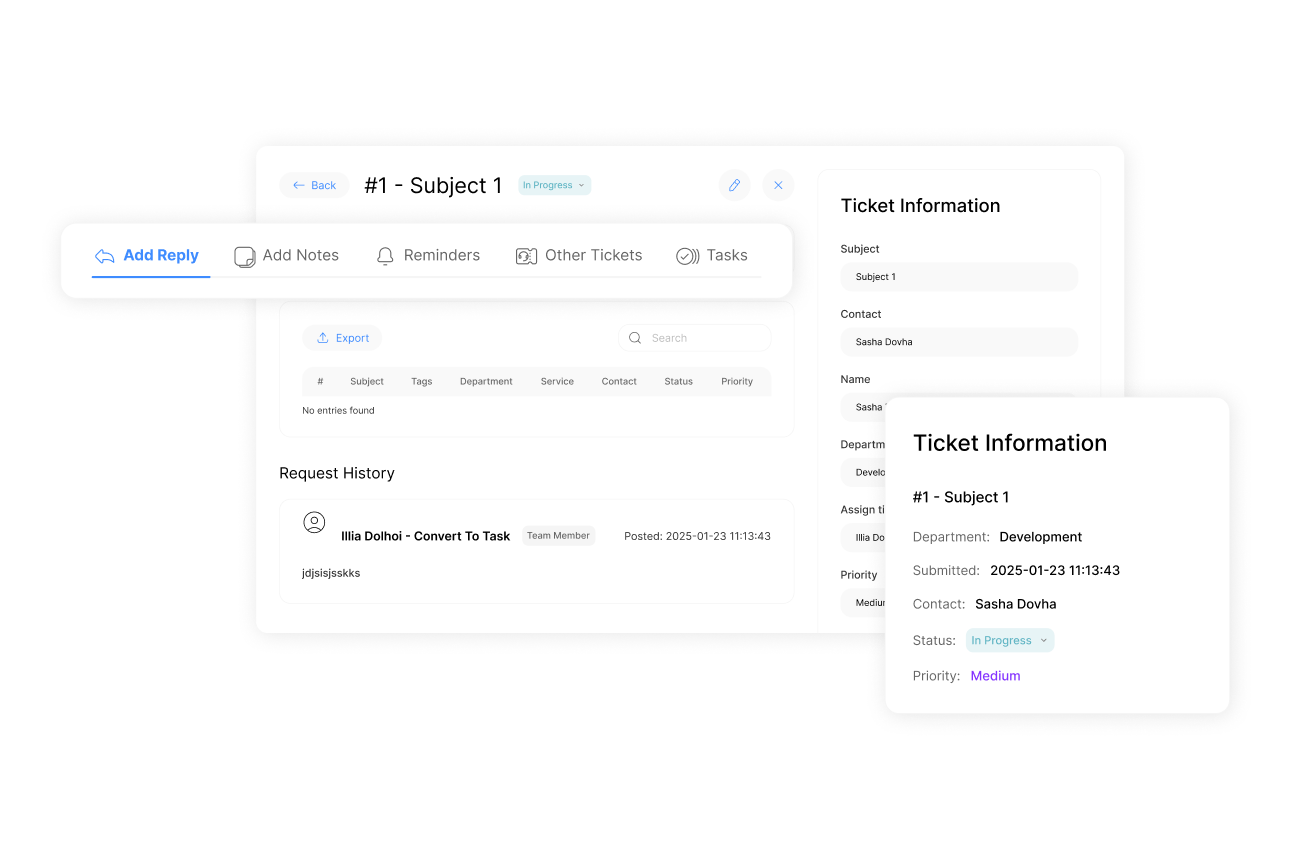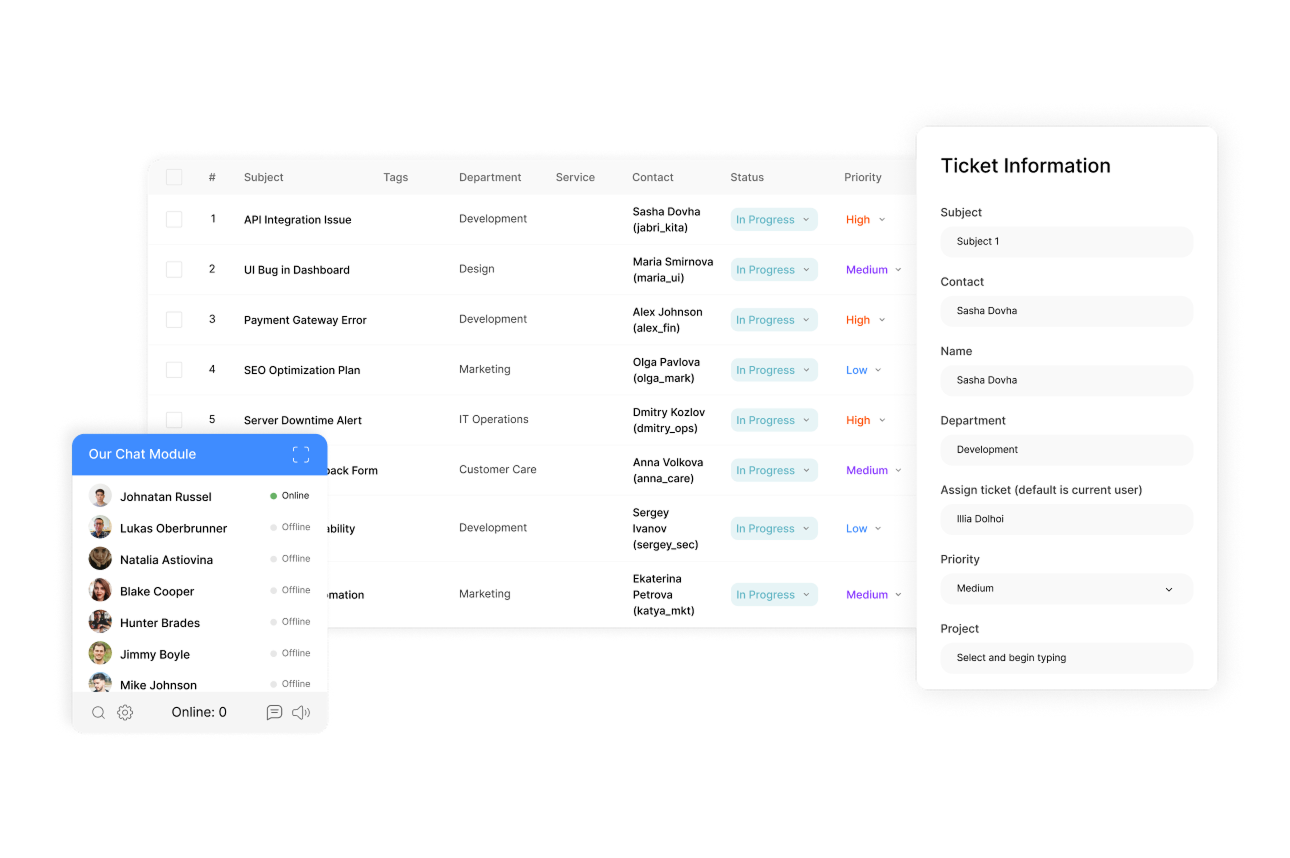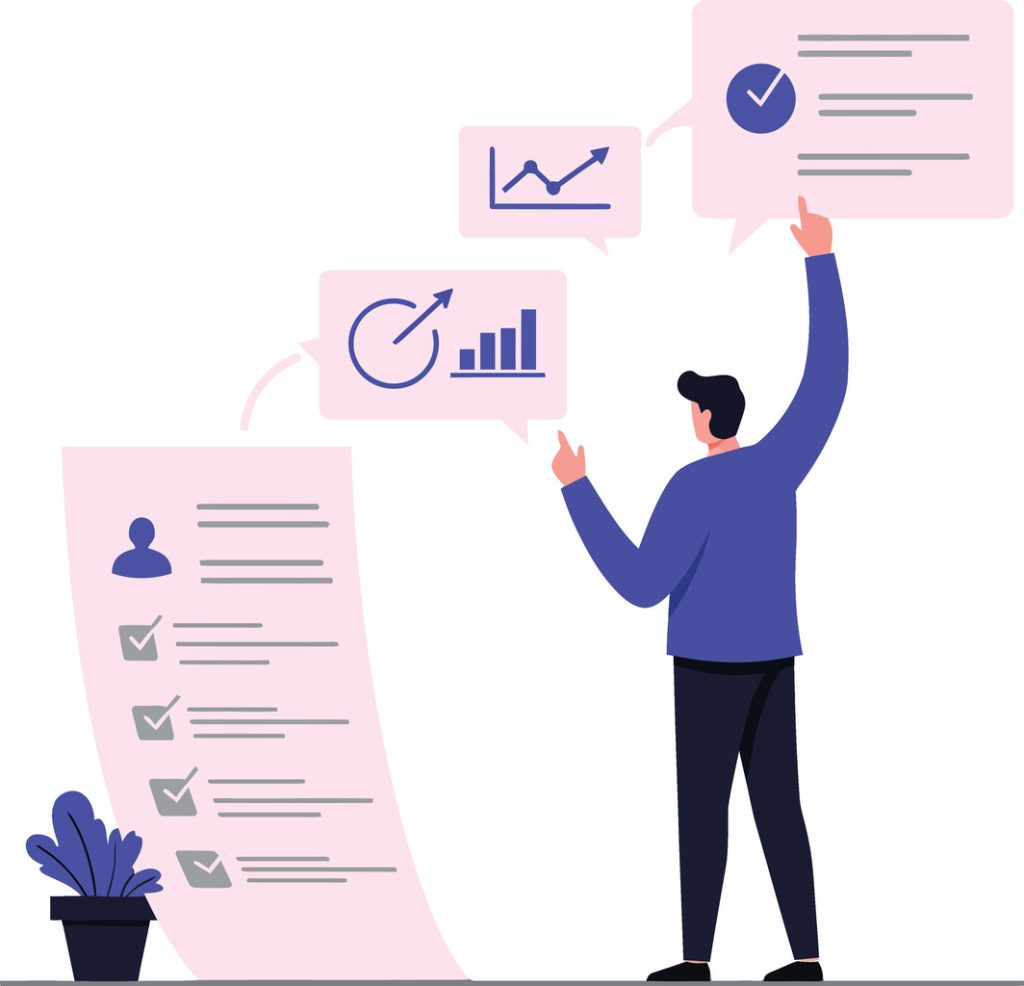Streamline Your Operations: Efficient Customer Tickets Management


Stay on Top of Every Customer Request
Track, manage, and resolve customer issues without anything slipping through.
ClearCRM turns conversations into actionable tickets tied to real customer data.
- Auto-create tickets from emails or forms
- Link tickets to contacts, deals, or tasks
- View all open and resolved issues in one dashboard
Resolve Faster with Smart Workflows
Deliver support that’s timely, organized, and accountable.
Use built-in automation and assignments to speed up resolution.
- Assign tickets based on category or workload
- Set priorities, due dates, and internal notes
- Track status with Kanban or list views


Improve Support with Insights
Measure what matters and keep improving your customer service.
Built-in analytics help you monitor response times and team performance.
- View average resolution times and ticket volume
- Identify bottlenecks with filtered reports
- Use data to fine-tune your support process
Modern businesses face growing demands to resolve support requests quickly while maintaining organized workflows. A well-designed ticketing system transforms how teams handle inquiries by centralizing communication and automating repetitive tasks. This approach prevents requests from falling through the cracks, ensuring faster resolutions and clear accountability.
Centralized platforms consolidate emails, chats, and calls into a single dashboard. Teams gain full visibility into each issue’s status, from initial submission to final resolution. Industry reports reveal companies using these tools reduce response times by up to 40%, directly boosting client retention rates. By integrating various communication methods, these platforms facilitate quicker collaborations and decision-making among team members. Moreover, streamlining team communication processes fosters a more cohesive work environment, enabling teams to share insights and strategies effectively. As a result, companies can not only improve operational efficiency but also enhance overall client satisfaction.
Beyond organization, structured systems improve resource allocation. Managers identify recurring service bottlenecks through real-time analytics, allowing proactive adjustments. Retail and tech sectors, for example, leverage automated routing to prioritize urgent cases—cutting resolution times without sacrificing quality.
Adopting such solutions also strengthens data-driven decision-making. Historical feedback trends highlight areas for improvement, while performance metrics align teams with organizational goals. The result? Higher satisfaction scores and repeat business.
Key Takeaways
- Centralized systems unify communication channels for seamless tracking
- Automated workflows reduce manual tasks and accelerate resolutions
- Real-time analytics expose inefficiencies in service delivery
- Prioritization features ensure critical issues receive immediate attention
- Performance data drives continuous process optimization
Understanding Customer Tickets
Effective inquiry management hinges on structured documentation processes. A support ticket acts as a digital blueprint, capturing every detail of a client’s request. From initial contact to final resolution, this tool ensures consistency across teams while maintaining audit trails. Furthermore, support tickets can feed into a robust knowledge base for customer support, enabling teams to share insights and solutions effectively. This centralized repository not only enhances collaborative efforts but also empowers clients to find answers independently. By leveraging this system, organizations can streamline their support processes and improve overall customer satisfaction.
What Defines a Support Ticket?
Each ticket combines critical data points into a unified record. Essential components include:
| Component | Purpose | Impact |
|---|---|---|
| Unique ID | Tracks issue lifecycle | Prevents duplicate work |
| Interaction History | Documents all communications | Accelerates context retrieval |
| Priority Level | Guides workflow sequencing | Reduces resolution time by 30%+ |
For example, IT departments use ticket status updates to flag recurring system errors. Retailers apply categorization to manage holiday surge demands efficiently. Centralized threads eliminate confusion—especially when multiple agents collaborate on complex cases.
Importance in Service Operations
Clear ticket definitions prevent workflow collisions. When a telecom company implemented standardized templates, misrouted requests dropped by 52% within six months. Real-time ticket status visibility lets teams:
- Identify bottlenecks in escalation paths
- Allocate specialists based on skill match
- Measure first-response efficiency
One retail chain reduced average handling time by 41% after integrating resolution tracking into their ticketing system. Such precision directly correlates with higher satisfaction rates and operational scalability.
The Role of Support Ticketing Systems in Streamlining Operations

Organizations leveraging modern ticketing systems eliminate chaotic workflows by unifying fragmented communication streams. These platforms act as command centers, transforming scattered inquiries into structured action plans. A Forrester study found businesses using centralized tools reduced average response times by 35% while improving cross-team collaboration.
Centralizing Customer Interactions
Unified hubs merge emails, live chats, social media messages, and calls into one interface. This prevents critical requests from disappearing between departments. Key advantages include:
- Eliminating duplicate efforts through shared access to interaction histories
- Automatically categorizing inquiries by urgency or topic
- Providing 24/7 visibility into unresolved cases
Leading platforms like those featured in our comparison of top CRMs for small integrate omnichannel support, ensuring no query goes unanswered. Retailers using these solutions report 43% fewer missed inquiries during peak seasons. These advancements not only enhance customer satisfaction but also boost team efficiency by streamlining communication across various channels. As retailers seek to optimize their operations, many are turning to the best crm solutions for support teams, which offer robust features tailored to their needs. This integration is proving invaluable in creating seamless experiences for both customers and support staff alike.
Tracking Ticket Status Effectively
Real-time dashboards display every ticket’s progress, from assignment to resolution. Teams identify bottlenecks instantly—like a SaaS company that reduced resolution time by 28% after implementing status alerts. Automation further optimizes workflows by:
- Routing complex issues to specialized agents
- Sending escalation reminders for overdue cases
- Updating clients via automated progress notifications
This transparency builds trust. Service teams using live tracking tools achieve 19% higher satisfaction scores, according to Zendesk’s 2024 CX Trends Report.
Benefits of an Efficient Ticketing System

Operational excellence in service delivery starts with structured workflows. Modern ticketing systems elevate performance across three critical areas: speed, satisfaction, and strategic improvement. These tools transform reactive firefighting into proactive problem-solving.
Faster Resolution Times
Automated routing sends urgent cases to qualified specialists instantly. A Forrester study shows teams using prioritization features reduce average handling time by 40%. This agility prevents backlogs during peak periods—crucial for industries like finance where delays cost credibility.
Enhanced Satisfaction
Timely follow-ups build trust. Systems with automated progress updates keep users informed, aligning with 92% of clients who value transparency (Zendesk 2024). One SaaS company boosted satisfaction scores by 22% after implementing SLA compliance alerts.
Data-Driven Insights
Analytics uncover hidden patterns in support interactions. Managers identify:
- Common pain points requiring product adjustments
- Training gaps affecting first-contact resolution rates
A healthcare provider reduced patient portal inquiries by 31% after analyzing recurring feedback trends. Continuous optimization turns raw data into competitive advantages.
Industry Applications of Customer Tickets
Adaptable workflow solutions drive success across sectors by tailoring ticketing systems to unique operational demands. From healthcare to municipal services, structured platforms resolve industry-specific challenges while maintaining service consistency.
Healthcare and Patient Management
Hospitals leverage support ticket tools to streamline appointment scheduling and medical inquiries. A 2023 HIMSS report showed clinics using these systems reduced patient no-shows by 27% through automated reminders. Centralized dashboards enable staff to:
- Track prescription refill requests in real time
- Prioritize urgent cases based on symptom severity
- Coordinate follow-ups across specialists
One Midwest hospital network cut response times for patient portal messages by 33% after implementing priority tagging. This precision improves care quality while reducing administrative strain.
Retail, E-commerce, and Government Services
Online retailers resolve 89% of order disputes within 24 hours using automated return authorization, per Shopify data. Ticket categorization separates product questions from shipping issues, letting teams address high-impact cases first. Government offices apply similar logic:
- Automated forms route citizen complaints to relevant departments
- Status updates keep users informed during lengthy processes
A municipal office in Texas reduced permit application delays by 41% after adopting a unified service management platform. SaaS companies further demonstrate scalability—one tech firm boosted satisfaction scores by 19% by integrating AI-driven response suggestions into their support workflow.
Implementing a Seamless Ticketing System for Your Business
Deploying an optimized workflow solution requires strategic planning aligned with operational goals. Successful implementation balances technical capabilities with team readiness, ensuring smooth adoption across departments.
Assessing Business and Customer Needs
Begin by mapping current pain points through stakeholder interviews and data analysis. Identify peak inquiry volumes, common request types, and existing bottlenecks. For example, a logistics company discovered 38% of delays stemmed from misrouted emails—a fixable issue through proper channel integration.
Choosing an Omnichannel Support Platform
Prioritize platforms offering unified inboxes with email, chat, and social media integration. Key evaluation criteria include:
| Feature | Business Impact |
|---|---|
| AI-powered routing | Reduces assignment errors by 52% (Velaro 2024) |
| Mobile access | Enables 24/7 response capabilities |
| Third-party integrations | Streamlines data flow between CRMs |
Customizing Workflows and Automating Assignments
Configure rules to direct inquiries based on urgency, complexity, or agent expertise. A Midwest retailer automated return authorization, slashing processing times from 48 hours to 90 minutes. Pair automation with ongoing staff training—teams using simulation exercises achieve 67% faster system mastery.
Implement performance dashboards tracking first-response rates and resolution metrics. Continuous analysis spots trends like seasonal spikes, enabling proactive staffing adjustments. This data-driven approach keeps operations agile and client-focused.
Optimizing Ticket Management in IT and Business Operations

High-volume environments demand precision-driven strategies to handle inquiries without compromising speed. Advanced ticketing systems transform chaotic workflows through intelligent categorization and real-time analytics, enabling teams to resolve 23% more issues weekly (Gartner 2024).
Prioritizing and Categorizing Tickets
Effective sorting starts with a three-tiered framework:
- Impact matrices: Classify requests by potential revenue loss or operational disruption
- Automated tagging: Assign labels like “Network Outage” or “Software Bug” using AI analysis
- Escalation protocols: Route critical cases to senior specialists within 15 minutes
An IT department at a Fortune 500 company reduced system downtime by 41% after implementing severity-based queues. Their four-level priority scale accelerated response to server failures while maintaining routine maintenance schedules.
Leveraging Analytics for Process Improvement
Historical data reveals patterns invisible in daily operations. Teams using diagnostic dashboards achieve:
- 19% faster identification of recurring software glitches
- 35% reduction in repeat inquiries through root-cause analysis
- 12% improvement in first-contact resolution rates
One MSP increased client retention by 27% after correlating resolution times with satisfaction scores. Their weekly review process eliminated seven redundant approval steps, cutting average handling time from 8.2 to 5.6 hours.
Continuous refinement separates top performers. Update categorization rules quarterly using feedback from support teams and end-users. Pair automated distribution with live performance boards to maintain agility during crisis events.
Best Practices for Enhancing Customer Support with Customer Tickets
Refining support operations demands deliberate strategies that balance clarity with adaptability. Teams achieve consistent results by standardizing documentation processes while maintaining flexibility for unique scenarios. Structured protocols ensure every interaction drives toward measurable improvements in efficiency and user experience.
Optimizing Initial Issue Documentation
Comprehensive submission forms guide users to provide actionable details upfront. Required fields like error codes or transaction IDs reduce back-and-forth exchanges. A 2024 Zendesk study found organizations using dynamic forms cut follow-up requests by 35%.
| Form Component | Implementation | Outcome |
|---|---|---|
| Attachment Upload | Screenshots/Log Files | 48% faster diagnosis |
| Dropdown Menus | Predefined issue categories | 79% accurate routing |
| Progress Tracking | Real-time status updates | 22% fewer status inquiries |
One e-commerce brand reduced escalations by 41% after adding video recording options to their ticketing interface. Guided reporting minimizes ambiguity, letting specialists address root causes immediately.
Building Competency Through Knowledge Sharing
Ongoing education transforms support staff into problem-solving experts. Effective programs combine:
- Biweekly workshops on emerging product features
- Simulated crisis scenarios with timed resolutions
- Peer-reviewed case studies from complex tickets
A telecom provider boosted first-contact resolution rates by 29% after implementing certification-based task assignments. Centralized knowledge bases with searchable solutions further empower teams to deliver precise responses under pressure.
Regular feedback analysis closes the improvement loop. Teams reviewing client surveys monthly identify trending pain points 63% faster. One SaaS company redesigned their onboarding process based on recurring ticket themes, achieving 19% higher retention in Q1 2024. These practices create self-optimizing workflows where every interaction fuels operational excellence.
Conclusion
Businesses that master ticketing systems gain measurable advantages in today’s fast-paced markets. Centralized platforms cut response times by up to 40% through automated workflows, while real-time dashboards expose bottlenecks before they escalate. Structured data turns every customer interaction into actionable insight. For example, retailers using these systems resolve 89% of inquiries within 24 hours.
Industries from healthcare to municipal services achieve consistent results by aligning technology with operational needs. Unified platforms reduce misrouted cases by 52%, ensuring specialists address high-impact issues promptly. Analytics-driven adjustments further optimize resource allocation, driving continuous improvements in resolution rates and client satisfaction.
The integration of intelligent routing and performance tracking creates self-improving workflows. Teams leveraging these solutions report 19% higher retention rates and 35% fewer repeat inquiries. Scalable systems adapt to fluctuating demands without compromising service quality.
Decision-makers seeking operational excellence should prioritize platforms offering omnichannel support and AI-enhanced analytics. Proven systems turn chaotic workflows into strategic assets, directly impacting revenue and reputation. Adopt a ticketing solution that grows with your business—start streamlining operations today.

